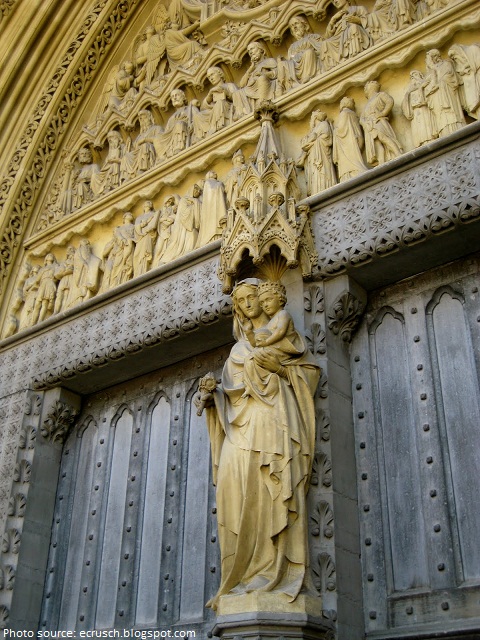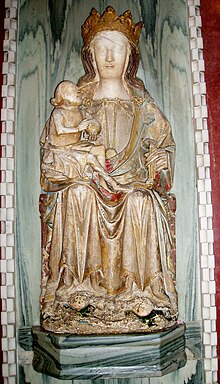Our Lady at the North Door must refer to the transept front of the church as rebuilt by King Henry III in the period 1245-69. This may well have been the main processional entrance into the abbey for much of the fourteenth and fifteenth centuries. The doorway itself, very much created with French inspiration in mind was to be largely copied for copied at Lincoln for the Angel Choir. In the fourteenth century a Galilee porch was added about 1362, This was demolished about 1662 by Sir Christopher Wren as part of his renovation of the abbey. It must be said that it had a slightly curious appearance as it projected out taking its roof line from the gable over the earlier doorway
The north side of Westminster Abbey in 1654 by Wenceslaus Hollar. The Galilee Porch can be seen covering the north portal
Image: Alamy
Heavy restoration in the nineteenth century by Scott in the 1870s and especially that by Pearson in the 1880s and 90s has attracted driiticidm for making the facade now an entirely Victorian piece.
The North Transept of Westminster Abbey
Image:justfunfacts
Scott restored statues to the front, although his ground floor scheme for them was not completed after his death beyond the Virgin and Child on the trumeau.
Image: justfunfacts.com
The second point of pilgrimage lies inside the abbey at the shrine of Our Lady of Pew, it was here that the origin of the gift of England as the Dowry of Mary lies in the events at the culmination of the Peasants Revolt in 1381. There is an excellent account of this in its spiritual and cultural context as well as locating it in historical events by my friend, the late Fr Mark Elvins OFMCap, His article can be read online at England - the Dowry of Mary. As he shows the statue in the tiny chapel was then s new feature, given in 1377 by the Countess of Pembroke and venerated by the monks who no longer had access to a similar image in the Royal Chapel of St Tephen in the adjoining Palace. Fr Mark discussed possible origins of the name but another possibility is that the chapel was just that - a pew. It may have been that this was a private place for use by King Richard II when he came to attend Mass celebrated in the adjoining Chapel of St John the Baptist. The King had an especial devotion to the saint, and his original baptismal name may have actually been John. He clearly saw the Baptist as his patron, and stated this on his tomb inscription. The Pew chapel includes the King’s White Hart badge amongst its surviving painted decoration. In 1524 the wall and opening looking into the chapel were opened out as a new entrance into St John’s Chapel with the blocking of the original entrance with the tomb of Bishop Ruthsll of Durham. There is a good description of the linked chapels with some interesting illustrations at The little chapel in Westminster Abbey, beloved of Richard II
Fr Marlk mentions in his article the Wilton Diptych. Anyone interested in the court culture - be it spirituality, politics, art, literature, fashion or patronage - should look at the book by Dillian Gordon et al, and entitled The Wilton Diptych. ( 2015 Yale UP and the National Gallery). It is not expensive for what it covers and is one of the most beautiful books one can imagine not only in its subject but also in the quality of its design, binding and presentation.
The entrance to the Chapel of Our Lady of Pew, with the modern statue and showing some of the surviving medieval painted decoration.
Image: Alamy
Mother Concordia carved a new statue in alabaster which was installed in 1971. The original statue appears to have been a standing figure, but the new one is an enthroned Virgin and Child
It is based closely on the one now in Westminster Cathedral. This is an English fifteenth century piece presumabky from the Staffordshire-Derbyshire centre of the alabasterer’s craft. In 1863 a virtually identical figure was dug up in the churchyard at Broughton-in-Craven in Yorkshire. The one now in Westminster Cathedral May have been one which survived by being sold abroad. In 1550 shiploads of such religious artificers were leaving English ports for the continent.
Just over four centuries later in 1954 this statue appeared in the market and it was acquired for the cathedral. All this is recounted and more besides in an excellent Wikipedia article at Our Lady of Westminster
Image: Wikipedia
Our Lady of Westminster Pray for us







No comments:
Post a Comment